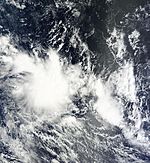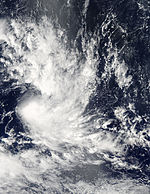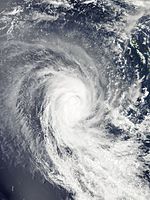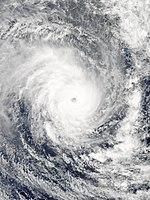2014–15 South Pacific cyclone season
| 2014–15 South Pacific cyclone season |

Season summary map
|
| Seasonal boundaries |
| First system formed |
November 21, 2014 |
| Last system dissipated |
July 4, 2015 |
| Strongest storm |
|
| Name |
Pam |
| • Maximum winds |
250 km/h (155 mph)
(10-minute sustained) |
| • Lowest pressure |
896 hPa (mbar) |
| Seasonal statistics |
| Total disturbances |
16 |
| Total depressions |
12 |
| Tropical cyclones |
6 |
| Severe tropical cyclones |
2 |
| Total fatalities |
16 |
| Total damage |
$360.4 million (2014 USD) |
| Related articles |
|
|
South Pacific tropical cyclone seasons
2012–13, 2013–14, 2014–15, 2015–16, 2016–17
|
| Tropical depression (Australian scale) |
|
|
| Duration |
November 21 – November 26 |
| Peak intensity |
Winds not specified 1003 hPa (mbar) |
| Tropical depression (Australian scale) |
|
|
| Duration |
December 20 – December 26 |
| Peak intensity |
55 km/h (35 mph) (10-min) 998 hPa (mbar) |
| Tropical depression (Australian scale) |
|
|
| Duration |
December 21 – December 24 |
| Peak intensity |
Winds not specified 1000 hPa (mbar) |
| Tropical depression (Australian scale) |
|
|
| Duration |
December 23 – December 29 |
| Peak intensity |
Winds not specified 1000 hPa (mbar) |
| Category 2 tropical cyclone (Australian scale) |
| Tropical storm (SSHWS) |
|
|
| Duration |
January 19 – January 25 |
| Peak intensity |
100 km/h (65 mph) (10-min) 982 hPa (mbar) |
| Category 3 severe tropical cyclone (Australian scale) |
| Category 2 tropical cyclone (SSHWS) |
|
|
| Duration |
January 29 – February 3 |
| Peak intensity |
150 km/h (90 mph) (10-min) 955 hPa (mbar) |
| Category 5 severe tropical cyclone (Australian scale) |
| Category 5 tropical cyclone (SSHWS) |
|
|
| Duration |
March 6 – March 15 |
| Peak intensity |
250 km/h (155 mph) (10-min) 896 hPa (mbar) |
| Category 1 tropical cyclone (Australian scale) |
| Tropical storm (SSHWS) |
|
|
| Duration |
March 19 – March 23 |
| Peak intensity |
75 km/h (45 mph) (10-min) 990 hPa (mbar) |
| Tropical depression (Australian scale) |
| Subtropical cyclone |
|
|
| Duration |
March 28 – March 31 |
| Peak intensity |
55 km/h (35 mph) (10-min) 998 hPa (mbar) |
The 2014–15 South Pacific cyclone season was a period of the year when most tropical cyclones form within the South Pacific Ocean, to the east of 160°E. The season officially ran from November 1, 2014 to April 30, 2015. During the season, tropical cyclones were officially monitored by the Regional Specialized Meteorological Center (RSMC) in Nadi, Fiji and the Tropical Cyclone Warning Centers in Brisbane, Australia and Wellington, New Zealand. The United States Armed Forces through the Joint Typhoon Warning Center (JTWC) also monitored the basin and issued unofficial warnings for American interests. RSMC Nadi attaches a number and an F suffix to tropical disturbances that form in or move into the basin while the JTWC designates significant tropical cyclones with a number and a P suffix. RSMC Nadi, TCWC Wellington and TCWC Brisbane all use the Australian Tropical Cyclone Intensity Scale and estimate windspeeds over a period of ten minutes, while the JTWC estimated sustained winds over a 1-minute period, which are subsequently compared to the Saffir–Simpson hurricane wind scale (SSHWS).
Ahead of the cyclone season, the Fiji Meteorological Service (FMS), Australian Bureau of Meteorology (BoM), New Zealand's MetService and National Institute of Water and Atmospheric Research (NIWA) and various other Pacific Meteorological services, all contributed towards the Island Climate Update tropical cyclone outlook that was released during October 2014. The outlook took into account the ENSO neutral conditions that had been observed across the Pacific and analogue seasons that had ENSO neutral and weak El Nino conditions occurring during the season. The outlook called for a near average number of tropical cyclones for the 2014–15 season, with eight to twelve named tropical cyclones, to occur between 135°E and 120°W compared to an average of 10. At least four of the tropical cyclones were expected to become category 3 severe tropical cyclones, while three could become category 4 severe tropical cyclones, they also noted that a Category 5 severe tropical cyclone was unlikely to occur. In addition to contributing towards the Island Climate Update outlook, RSMC Nadi and the BoM issued their own seasonal forecasts for the South Pacific region.
...
Wikipedia



















